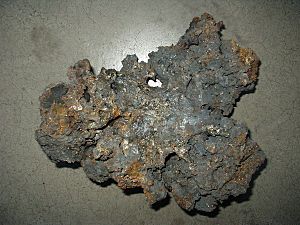Tamahagane facts for kids
Tamahagane (say it like tah-mah-HAH-gah-nay) is a very special type of steel made in Japan. The word tama means "round and precious", like a gem. The word hagane means "steel". So, Tamahagane means "precious steel"! This steel is super strong and is mostly used to make famous Japanese swords, like the Katana. It's also used for special knives and other tools. Because it's so special, Tamahagane can cost much more than regular steel. Good Tamahagane usually has about 1% carbon in it, which helps make it strong.
Contents
How Tamahagane is Made
Tamahagane is made from a special kind of iron sand, which is called satetsu in Japanese. There are two main types of iron sand: akome satetsu and masa satetsu. Masa satetsu is better quality.
The Tatara Furnace
The iron sand is put into a large clay oven called a tatara. This oven is about 4 feet tall, 12 feet long, and 4 feet wide. First, the clay oven is dried and then heated up to a very high temperature. It gets as hot as 1,000 degrees C (that's 1,832 degrees F!). Then, charcoal is added to the iron sand. The charcoal helps to make the Tamahagane very hard.
The Long Process
Making Tamahagane is a long process that can take from 36 to 72 hours. It depends on how many people are working and how much steel they want to make. During this time, more iron sand is added about every 10 minutes. The mixture is also turned over often to make sure everything mixes well.
Finishing the Steel
When the Tamahagane is ready, the clay oven is broken apart. The steel block is then carefully removed. The best quality steel is usually found on the edges of the block. This is because of a process called oxidation that happens there. You can tell the quality of the Tamahagane by its color. Bright silver pieces are considered the best for making strong blades.
Related pages
See also
 In Spanish: Tamahagane para niños
In Spanish: Tamahagane para niños


